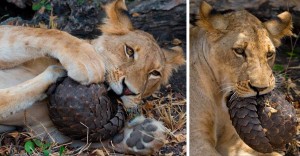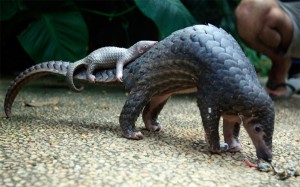There are four Asian pangolins:
• Chinese pangolin (Manis pentadactyla) – Critically Endangered
• Malayan/Sunda pangolin (Manis javanica) – Critically Endangered
• Indian pangolin (Manis crassicaudata) – Endangered
• Philippine pangolin (Manis culionensis) – Endangered
Size: Around 1.6kg – 33kg or 3.5lbs – 73lbs
Colour: Light to yellowish brown through olive to dark brown
They are found in a variety of habitats including tropical and flooded forests, thick brush, cleared and cultivated areas, and savannah grassland; in general they occur where large numbers of ants and termites are found. Nocturnal, solitary and highly secretive, they sleep in underground burrows during the day and emerge in the evening to forage for insects. They have tough overlapping scales made from keratin, the same protein that forms human hair and finger nails, that cover most of their bodies. The scales grow throughout the life of a pangolin just like hair, while the scale edges are constantly filed down as they dig burrows and tunnel through the soil in search of termites and ants.
Their undersides have no scales, but are covered with sparse fur instead. Asian pangolins have thick bristles that emerge from between their scales, distinguishing themselves from African pangolins. Their scales are good defense against predators as they quickly curl into a ball, protecting their defenseless undersides.
They also deter predators by hissing and puffing, and lashing their sharp edged tails. Pangolins identify their territories by scent marking with urine and secretions from a special gland, and by scattering feces. Such odours are suspected to advertise dominance and sexual status, and may also help individuals recognize each other.
Their diet is predominantly ants and termites, which they may supplement with various other invertebrates including bee larvae, flies, worms, earthworms, and crickets. It is extremely difficult to maintain pangolins in captivity as they often reject unfamiliar insect species or become ill when fed foreign food. Pangolins have poor vision, so they locate termite and ant nests with their strong sense of smell. Thereafter, they use their long, muscular, and sticky tongues that when fully extended, is longer than their head and body, to reach and lap up ants and termites in deep cavities. Watch the second video at the sidebar on the right labelled, “What is a Pangolin” by NatGeoWild for a clearer visual understanding of how a pangolin looks like and how they forage for food.
A pangolin’s stomach is muscular, contains small stones, and has keratinous spines projecting into its interior that it uses to mash and grind prey. Their limbs are stout and well adapted for digging; each paw has five toes, and their forefeet have three long, curved, claws used to demolish the nests of termites and ants and to dig nesting and sleeping burrows. They also have special muscles that seal their nostrils and ears shut, protecting them from any attacking insects. Special muscles in their mouths prevent ants and termites from escaping after capture .
Most Asian pangolins give birth to a single offspring, though two and three young have been reported. At birth, pangolins are about 6 inches long and weigh about 12 ounces (.75 lbs). Their scales are soft and pale, and begin to harden by the second day. Pangolin mothers nurture their young in nesting burrows and will protectively roll around her baby when sleeping or if threatened. Babies nurse for 3 – 4 months, but can eat termites and ants at 1 month. When the infant accompanies the mother out of the burrow, it rides on the base of her tail as she forages for insects.




